As I hinted in my last post, the Pokerbird has completed his transformation into Andy Gibb, which is what he was all along. This blog will continue to hold occasional poker thoughts but the bulk of my "stuff" will be on the new one. ⇒
Thursday, 5 November 2009
Monday, 19 October 2009
Approaching the Ultimate Limits?
Modern analysis of a generation-old book about population, production, consumption and pollution seems to show that its nightmare scenario is winning the race to be the most accurate. Prepare for meltdown somwhere around 2050. Thankfully I should be dead by then.
Prepare also for the migration of this blog to WordPress on my main website and its transformation into a journal about transformation and birds, of course.
Saturday, 17 October 2009
Semi-Bluff Reraising: A Winning Poker Play?

For fun, I've incorporated strict suited connectors (down to 54s) to my starting repertoire, which has increased the flops giving me four to a flush or straight. I have no problem semi-bluff betting them when I’m first to act, even if I've been sucked into calling a pre-flop raise. As far as I know, the board hasn't hit my opponents and I may as well bet for information at least or to steal the pot at best.
It’s less fun responding to another player’s post-flop bet. I’m not sure that reraising is working. For a start, I already have information: that my oppo likes his hand, unless he's continuation betting. So, the only motivation for reraising must be to steal the pot. And players are fighting back by re-reraising, damn their eyes. Then not only have I failed in my steal but I’m getting shite odds to call. And to call with a fair proportion of my remaining stack, indeed maybe committing all of it to the hand – not what I had in mind with marginal starting cards.
What if my opponent merely calls my raise? Do I continue the semi-bluff on the turn? Again at far greater cost than my budget for the hand? Basically, I’m getting into scary territory.
I think that floating is the answer. Call the bettor despite the lousy odds, even the implied odds, on the draw. There's still a chance to win the pot on the turn if he gives up the lead. I don't have to worry about distinguishing continuation bets either; I can treat them all the same.
The float doesn't work well against serial bettors, so it’s important to read them. It’s not good against multiple opponents either although, with a draw, they may generate good pot odds by calling. Really, it’s just any old excuse to stay in the hand and chase down a beautiful thing. The hard maths would determine the effectiveness of reraising versus floating but for now I’m going on instinct.
So much for a cash game. The situation in a tournament is different. In the name of pushing on, fast, early doors I'd reraise, even put my entire stack at jeopardy. A 2-1 chance to double up? Ease the next few levels? Be the table bully? Against spending an hour or two struggling to some grisly end, probably against the same odds?
In fact, I’m tending also to play one-gap suited connectors early in tournaments, which increases the reraising dilemma. But it’s a damn sight more fun than waiting for monster hole cards, especially when they’re overtaken to knock you out anyway.
Friday, 16 October 2009
Common Scoters, Bittell

My Worcestershire list moves on for the third time this month after the earlier great white egret and mandarin ducks. It takes unusual visitors to notch it up and these were sea ducks about as for inland as they could get. A mixture of fifteen females or juveniles treated me to a flying display when I got to the reservoir. Why no males?
I don't know. Much is not known about our only Red-Listed breeding duck except that it may not remain a native breeder. Mink, forestry and oil seem to be the main threats. The species is badly enough off to warrant its own Action Plan. So that's OK, then.
I don't know. Again. How about one great big Action Plan? Something inspired by the observation that “if we keep doing what we do, we'll keep getting what we get”, say.
Now let's talk about me. Or specifically my Bittell list, which has some weird omissions. Today I fixed some of them with little grebe, kestrel, pied wagtail, wigeon and shoveler. So I did well for ducks although I’m still missing teal and pintail, and will probably never add ruddy duck.
It’s been a ducky sort of month so far but it is the time of year when they start to fill our reservoirs, lakes and coastal waters. They're one of the joys of a British winter among... er, not many joys actually. And I’m not getting an escape to Australia like last year’s. (Did I ever mention that?)
Thursday, 15 October 2009
Do Ya Feel Lucky?

Well, do ya, punk? Clint’s immortal line in Dirty Harry could stand for our attitude to climate change. Asking if global warming is true or not is futile. Who knows? That question is a sideshow and begs the real question, which runs akin to Pascal's wager. Whether we believe climate change or not and the worst happens, we're fucked. If we don't believe and we're right, what have we lost? Relatively a little time, a little energy, a little prosperity. Maybe a lot but still nothing compared with everything.
So, our baleful effect on the planet needn't be true, just possible. A drunk after a fine old all-nighter in the pub could have come up with the concept and we’d still have to take notice of it. Or a bunch of old men compiling a book many centuries ago. How if the authors of the Bible had warned of worldwide destruction by not believing in global warming instead of personal damnation by not believing in God? Would climate change be a religion now, along with the same compelling reason to bet on it?
As it is a great many respected scientists and thinkers have devoted a great deal of observation and experiment to reach the same conclusion. Doesn't that make it more convincing? If not absolutely compelling. The nay-sayers insist at least on a debate. What a smokescreen this is, the old delaying tactic. When exactly does debate stop and action start? Again, who knows? It may be too late already. It may be time just to believe or not believe.
It is possible not to believe and yet still act. The wager allows this: we're not choosing a belief but a lifestyle. Do we feel lucky? I hope the environmentalists do. An article in the Telegraph suggests that learning to be lucky generates good fortune. Lucky people are more receptive, more aware, more apt to spot luck. We may need it.
For the sake of Blog Action Day, feel lucky, punk.
Wednesday, 14 October 2009
Redwings & Fieldfares, Upton Warren
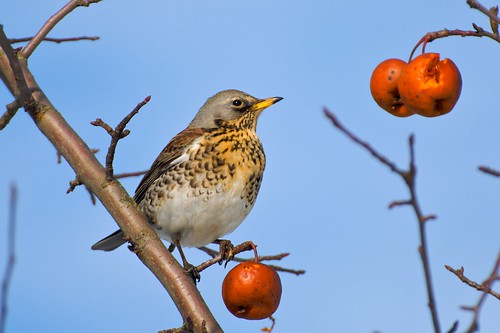
Bang on schedule, these winter thrushes are back. Last year I picked them up a day earlier; but what's a day between reuniting friends? The redwings are already numerous, the fieldfares less so. We saw only one small flock. Skylarks too were on the move. They're not an obvious migrant, being a native breeder, but large numbers fly down from their upland breeding areas and in from the north. Whether this means just Scotland or northern Europe, I don't know.
The fieldfares are an especial thrill with their bold patterns and chattering calls. They also have the coolest nest defence mechanism. Basically, they fly above predators and “shit on the bastards below”. Remember that from football songs of yore?
The two thrushes pushed me closer to my goal of 600 species for the year, as I predicted the winter birds would. The list stands at 578 with a trip to Scotland in the offing at the end of the month. Whooper swan, pink-footed goose, velvet scoter and turnstone should be easy, with maybe red-throated diver, purple sandpiper, crested tit, Scottish crossbill and twite depending on where I go. Locally I could still expect Bewick’s swan, grey partridge, Mediterranean gull, little owl, brambling and that darn bittern, reported on BirdForum, which didn't show again today. I’m also missing barn owl, lesser spotted woodpecker, tree sparrow and corn bunting, but Lord knows whither they've retreated.
What's that? 19 off the top of my head. It sounds easy but, like many birders, I over-estimate. The game is much harder than that.
Tuesday, 13 October 2009
10 Species You Can Kiss Goodbye
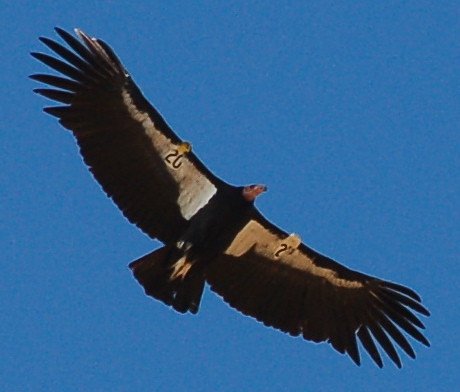
An interesting population countdown from LiveScience. I've actually seen one of these species in the wild - the condor, almost a dead cert (no pun intended) down the Big Sur coast of California. I wonder if any bookmakers are running bets on which will be the first species to go.
This sounds like poor taste but it could be the best publicity: get William Hill or someone to sponsor an endangered species and offer a price on its extinction. They'd have a strong motivation not to pay out on those bets.
Mind you it may also give criminals even more motivation to push them to extinction. I'd bet on the publicity winning out.
Australian Roads & Shopping
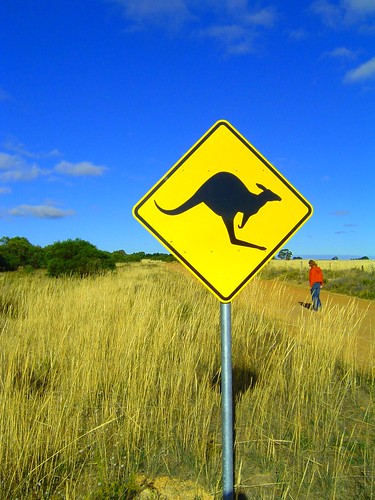
You know those roadside warning signs? Low-flying aircraft. Slippery when wet. Old people – always bent double; I’m not going to be like that, surely? Wild animals. And in Australia, kangaroos. They get their own special sign. And you know how you ignore them because the hazards never happen?
A mistake for the first one I passed on my way to Armadale from Perth. Just minutes after it, a large ‘roo bounded across the road in front of the car. No worries yet. The animal was far enough ahead and gone quickly enough that it presented no danger but the nether regions of my mind were firing synapses. I was on the brake pedal and checking for tailgaters without a conscious thought. “They travel in pairs,” I had read.
Sure enough, a second, smaller creature appeared under my left bumper. I had time and space to swerve and the animal must have sensed me too, because when I looked behind, the road was clear. No squished carcass. No thud either. No damage to the car. That would have been a good start to the trip.
Aware of the inverse irony of the situation, I drove more slowly that day, that week and for the bulk of the holiday, all the way from Adelaide to Cairns. It was truly ironic, then, that not a single other kangaroo road-hopped in all that time.
I stopped at Armadale, which seemed basically to be a shopping centre, as unremarkable as Redditch. Except that Redditch folk don't shop in bare feet. Nor does everyone in Armadale and at first I thought I was seeing some grossly underprivileged section of Australian society. It was weird and a little unnerving. Didn't these people even worry about broken glass or dog shit? But that was me being particularly British. Australia is relatively litter-free. The roadsides, for instance, are pristine compared with our corpse- and McDonald’s-strewn motorways. Down under, you only have to watch for the wildlife. ⇐ ⇒
Monday, 12 October 2009
Impressionist Mandarin Duck
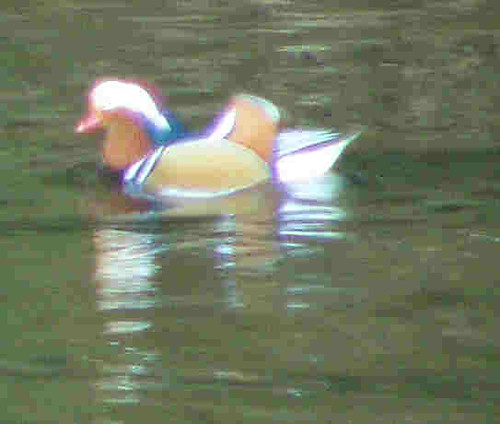
Were I sneaky enough, I'd assert that today I dashed this little watercolour off while watching a colony of mandarin ducks on the River Severn at Trimpley, Worcestershire. No-one who reads this blog knows my dismal 9-grade for art O-level aeons ago. However, the picture is the best I can salvage from my Olympus SP-560 stretched to full capability in trying to capture the flock right across the other side of the river. The Severn is wide at Trimpley! The ducks also refused to venture from the very strong shadows cast by the Wyre Forest and a blazing southerly sun.
Alien species seem also to be a Pokerbird theme but these guys are so handsome and apparently innocuous that they're worth a fifty-mile round trip, especially to become my 145th county bird. The list joins Hampshire, my birthplace, on this total, but both still lag Angus on 178. Santa Clara, over in Silicon Valley, beats everything hollow with 219. I know, I know: these figures are not a patch on the real record holders.
On the subject of dismal tallies, the Walkwood Watchers attempt at the Big Sit! yesterday actually bettered some other teams’ scores. Goddammit, we can't even win the wooden spoon!
Sunday, 11 October 2009
Buzzard Brings Down the Curtain on Big Sit!
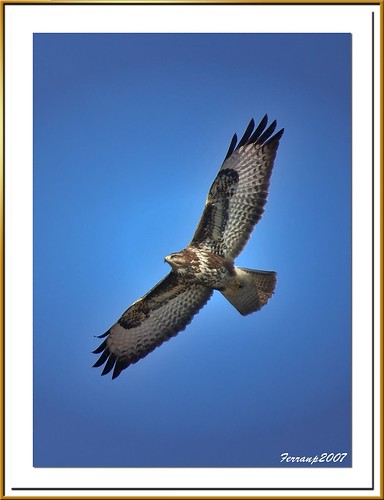
A raptor would have to figure prominently in a Pokerbird adventure, this time to bring the Walkwood Watchers’ day tally to a meagre 18 and prove my earlier prediction wrong. But what a great 18th bird and so nice to enjoy it without the fear of Maltese bastards gunning it to shreds. Not that they get a chance at our common buzzard; they pick (as though there were anything selective in their slaughter) on the honey buzzard, which isn't even in the same genus despite having a similar name. Buzzard clearly got applied liberally to birds of prey.
The local magpies took exception to it and at one stage four of them were trying to see it off. One persisted much longer than the others and at times I thought I would witness one of those moments photographed recently of the bird riding on the buzzard’s back. It didn't happen.
Nor did the Big Sit really. Unless we pull out a late tawny owl, not heard in these parts for nearly a year, or redwings fly over; and they were reported from the Wyre Forest this morning. The big miss was bullfinch. You expect one or two of those in a day but you also expect compensatory irregulars. We could have had several of woodpecker, nuthatch, goldfinch, starling, marsh tit, lesser black-backed gull, sparrowhawk or pied wagtail without raising eyebrows.
Ah well, here's to next year. ⇐
Big Sit! Score Struggles to 17
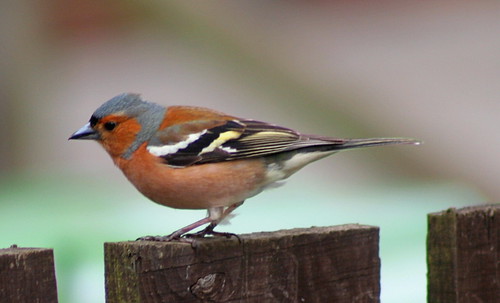
A flyover chaffinch has just added to the expected coal tit, jackdaw and jay in the last few hours. The mizzle – it could hardly even be called a drizzle – lasted until mid-afternoon; it doesn't really stop the birds coming in but it does stop the birders going out. A good thing I included four feet of dining room within the circle; this is England after all. At least we could watch the feeders.
The next targets are bullfinch and, strangely, buzzard. I see both every month but that doesn't guarantee every day. And the evening is already beginning to draw in. I’m guessing that, unless we get a last burst of sun, there's no chance of any raptors.
Chiffchaff and great spotted woodpecker bring up the second rank of birds I've seen frequently around Walkwood. Well, chiffchaff informs you I've not endured a winter here. Great spot though is a good candidate for at least being heard. The next two hours will tell. ⇐ ⇒
A Slow Start to the Big Sit!
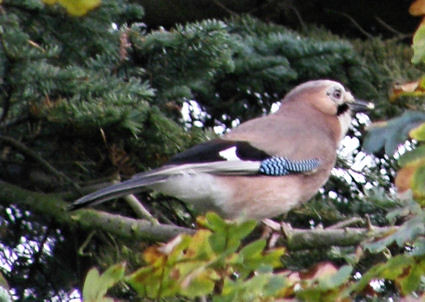
Slight drizzle is keeping the bird numbers down from within the Walkwood Watchers’ 17-foot circle. Before I did a quick stint out in the damp just now, only eight species had appeared, among them the usual suspects of blackbird, robin, wood pigeon, dunnock, greenfinch and blue and great tits. Long-tailed tit is never so numerous but they too were on the list.
The last five minutes added magpie, crow, a yaffling green woodpecker, wren and black-headed gulls calling somewhere over Morton Stanley Park. So, we're up to unlucky thirteen. Notable absentees thus far include coal tit, jackdaw and jay, which has been plentiful and obvious, collecting acorns over the last few weeks.
Hopeful of a few of the less regular species, we're still on for around twenty. There's time left to sponsor as well if you’d care to support BirdLife Malta and the RSPB. ⇐ ⇒
Saturday, 10 October 2009
Free Games #1: The Big Sit!
Tomorrow sees the world’s best non-competitive competition, organised by the Bird Watcher's Digest. Basically a team counts all the species of bird seen or heard from within one 17-foot diameter circle. Note that it’s the team not the birds who are restricted to the circle! A flyer (no pun, I’m sure) details the full rules of the challenge.
The Walkwood Watchers, that is Dave (who doesn't know it yet) and I, will probably struggle to get much beyond a count of twenty but is inviting sponsors. I’m in for 50p a species. We'll send the money to BirdLife Malta, whose current home page video is just sickening, and the RSPB. I have to include them: any organisation whose president says “vagina” on the telly has my vote! Good on yer, Kate.
Back to the Big Sit! Anyone out there fancy taking on the might of the Walkwood Watchers? Or at least sponsoring us? ⇒
Friday, 9 October 2009
Scottish Icterine Warblers

Oh, Lordy. Here's another tricky, non-descript species to get to grips with, found thanks to work on the BTO Breeding Atlas. No, no, no, it's a Good Thing, right? Yes, it is.
Moon Crash vs. Chicxulub Crash: Away Win
The conspiracy theorists and panic-mongers are having a fine time with NASA’s plan to crash a rocket into the Moon at 12:30 today. Will it be the end of the world as we know it? Hardly. That little world suffers a good dozen similar collisions every year and the craters we see from here show it survives impacts that dwarf one piddly rocket.
Coincidentally, I've just read about the meteorite that hit Chicxulub 65 million years ago, at the end of the Cretaceous Period. That was a crash.
I can only get my head round it this way. Imagine taking a Redditch-size ice-cream scoop out of the planet, preferably Redditch itself. There's your meteorite, more like an asteroid, what? Now fire it out of a great big gun, let's say at South Wimbledon, another shite place where I’ve lived.
On a planetary scale hurling Redditch at a bit of London is pretty small beer – just a pinprick on the globe – but if you were anywhere near it... how near? Most of us have felt that satisfactory thump of something quite big going off, like a huge firework. Imagine a house going off then, or a plane (I’m sure we can all do this), or an office block, then a complete town. You’d get out of the immediate neighbourhood.
So now, how far? Well, the Chicxulub impact threw up instant Himalayas ninety miles away. Curiously, that's Redditch distance. That's Coventry too. See how I've got it in for some places? Actually that's the entire south-east of England done for and it doesn't end there. Wikipedia fills in the next few moments better than I could.
It also posits a tsunami because Chicxulub at that time was on a continental shelf. Look at the height of this wave though – half a mile to a mile. The recent ones in Samoa and more distantly Indonesia, terrible as they were, didn’t even crawl out of the cradle in comparison.
Not much to do with birds but, of the dinosaur family, they may be the only survivors from the mass extinction that followed. The meteorite might not have been the sole culprit: the ecosystem was already under stress from a vast series of volcanoes separating India from Madagascar. In any case the Tertiary Period and large mammals were on their way in. That was the K-T Boundary that was.
I don't think we'll get the same show from NASA’s rocket.
Thursday, 8 October 2009
Newsletter

Need a summary of The Gibb Life? Bung me an email address and I’ll throw it on the mailing list. Limited edition of one trillion only. Hurry.
Wednesday, 7 October 2009
The Rhythm of Nature
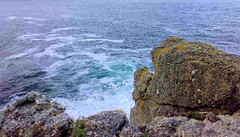
On the second day of my voluntary seabird-watching job the wind wrecked our sheltering umbrella construction and drove a spray up into our optics. Again, we needed the arrival of John who moved us further up the cliff to get us out of the weather’s worst. Still, visibility was bad with frequent showers and often the only object of interest was a rock just below our viewpoint.
The tide was such that an occasional wave would wash over the rock, leaving on its surface a pool which gradually disgorged back to the sea through a couple of waterfalls. One of the flows was quite robust but the other would sometimes dry up before the next replenishing wave. I fell into a reverie of imagining the falls in Yosemite and how they operated on the same principle, except with snow as their reservoir. A mild panic even began to set in when, rarity of rarities, the main waterfall threatened to falter.
It never did. Whoosh, wave. Pool, falls. Vigorous waters, slowing. One fall, drying, sometimes dried. Whoosh, wave...
That's what the hours can do to you. Again, it was a different pace of life, relaxing into the pulses of the natural world. And the day passed quickly. Before I knew it, I was back at the B&B and marking up the final totals for an email to Russell and BirdGuides. Yes, my day wasn't over until the paperwork was done and the paperwork showed 25 Balearics for the two days – bang on target thus far. ⇐ ⇒
An Albatross-Eye View
Not quite a movie but a camera snapping away every thirty seconds has filled in some gaps in our albatross knowledge. These pictures have come from round about the saddle of three individuals and give a hypothetical rider's view. Clearly this is fascinating from the ornithological perspective but also provides a glimpse of what's really out there in the oceans - something still pretty much a mystery.
Monday, 5 October 2009
Another Excuse for Gun-Happy Morons to Wage their War on Birds
This time it's the poor old parakeets that people, mark you, introduced to this country. And here we are trying to tell Malta that the greater any list of legal targets, the more the wanton killers can cover up any illegal hunting.
Sunday, 4 October 2009
Great (White) Egret, nr Pershore

Egretta alba according to the Collins Bird Guide; Ardea alba to Wildlife Recorder (WR) and BirdGuides, which includes the “White” in its name. WR only includes “White” for its alternative Egretta alba scientific name. Sibley in the US and Morcombe in Aus both agree on great egret Ardea alba but Robertson & Heather in New Zealand call it white heron Egretta alba. And Robson for South-East Asia throws a complete spanner in the scientific works with Casmerodius albus.
Is this the same bird around the world? To which genus does it belong? Ardea tends to be the herons and Egretta, the egrets. I've had trouble with consolidating worldwide records for this species since I first started seeing it. The confusion seems to be historic and Wikipedia suggests that the egret is in fact a heron, with the possibility that the down-under race is a separate species.
Got that straight? The visitor to Worcestershire showed for all of three seconds this afternoon, less than 1% of the time it took to sort out its taxonomy. Still, the glimpse was long enough to identify black feet, which in the absence of an accurate size is the best distinction from little egret. I was happy enough with it anyway.
Saturday, 3 October 2009
1999: Fulmar and Sandwich Terns at Lyme Regis

OK, I've a whole series of these things from ten years ago, this time August 25. Like I said: I've been at this game for a while:
"I had driven through nearly an hour of torrential rain and lightning from the M5 down to Lyme Regis. Chard had threatened to turn into Venice with waterfalls cascading off roofs to join the rivers forming in the streets. I was beat almost before the trip had begun.
Lyme itself was not much better. I spent another hour trying to find shelter to eat my sandwiches. Only the Herring Gulls looked relatively unperturbed.
However, in the midst of all this gloom and murk another gull flew across the front and veered out to sea. I don't know why I noticed it particularly -- some sixth sense maybe? As it turned away its flight action became more apparent -- those stiff wings, flickering more than beating. I got the binoculars on to the bird and sure enough the colouring and shape was all Fulmar. Suddenly munching a rye bread and Marmite sandwich in a sodden Dorset town did not seem like such a bad idea after all.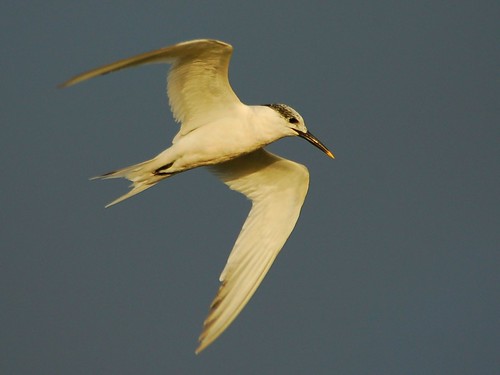
Later the weather turned completely and it became too hot for jeans and t-shirt. It also became possible to check out the other birds. A pair of terns called out at sea. I suspected Sandwich Tern from the shape, and the call did not seem like that of a Common; but I am no expert and these birds were too far out to tell for sure. Five minutes passed and the pair obliged by settling on the fast disappearing rocks 100 meters away. This time I could definitely make out the yellow tip to the bill and the slight crest.
A smart pair of Grey Wagtails, possibly my favourite bird, on the stream running through the town was a welcome late addition to the day's list. Then I had to head back to Winchester."
Movie Star at Arrow Valley Park, Redditch
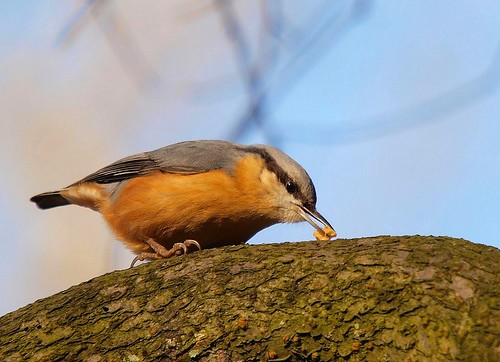
Not really but, in an odd departure from the factual, my Collins Bird Guide describes the nuthatch as visiting birdtables in worst Rambo style. This is not the first time the Pokerbird has associated a nuthatch with a film. There must be something about the Sittidae family, maybe that Zorro-like mask? Digression apart, today was my first record of our nuthatch at the Valley to bring my score there up to 67. I also logged only my second sighting of tufted duck, which Upton usually delivers for Worcestershire.
Now fully attuned to the phenomenon, I heard one partial burst of a chiffchaff’s song, which is a lot more normal than the full works that have grabbed the country’s attention lately. A grey wagtail broke a five-month drought for what is my favourite species. This is too long and it’s not as though I've been avoiding their habitat: I religiously check streams and ponds for them.
This one obliged by giving me good binocular views and even wagged its way into the same scene as a song thrush, a bird that I totally missed last month. That would have been a great picture if I'd had a camera and 2000mm lens; they were that far away. The sight is lodged in my mind instead, which is what counts really.
Friday, 2 October 2009
The Meaning of the Chiffchaff’s Autumn Song?

Fascinating edition of Autumnwatch this evening, if a bit exhausting. Maybe it’s my age (and a considerable amount of Banrock Station). I was at least alert enough to register the bit about chiffchaffs singing. I’ve never been aware of this in the autumn, yet today one was very obvious outside the West Hide at Upton and last week another was calling in Walkwood. Now it seems that others have noticed it too.
What can it all mean?
Mute Swans, Upton Warren

Seems like they've done well this year, six cygnets all looking a decent, easily defended size. Until recently I laboured under the common misapprehension that the Romans introduced the species into Britain but it appears they merely domesticated the bird. Mute swans are more native than we are. In fact only a handful of species are more alien.
One undoubted stranger graced the Moors Pool this morning too. It looked more ruddy shelduck than anything else but also included touches of red-breasted goose, mallard and Egyptian goose. It would be interesting to see its family tree. These weird hybrids turn up often.
Also regular at Upton, teal, lapwing, Cetti’s warbler (seen!), tufted duck and reed bunting were present. I note them especially just to ensure that they appear in my Worcestershire list. As I left, a couple of swallows dashed across, the latest I've seen them in the county. They must have been hightailing it for the South Coast, where they will hang on, maybe till the end of the month.
No winter returnees yet but it can't be long.
Thursday, 1 October 2009
Great Tits in Walkwood

The only wonder is that I’ve resisted that headline for so long. Actually the coppice was dripping with the birds on my start-the-month-list stroll this morning. Their buzzy, rattling calls and sharp, insistent cheep-cheeps filled the glades. These are just two examples of their vocal repertoire, which some authorities number at 57 – as many varieties as Heinz, which sounds just a little too coincidental. It’s a lot anyway, enough that great tits are probably the source of any unidentified noise in a patch of British woodland.
They're cheerful, cheeky little chappies too, which got me to thinking again about the robin’s autumn song. One hears it and feels it as melancholy but is it really that way round? Pre-music I can imagine early people getting the blues as the year declined, with which the song would have been inextricably linked. Then when we came to making our own music and wanted to express sadness, might that have sounded a bit robin-like? I bet this isn't an original idea.
I know I've banged on about my year list for 2009 but, taking a non-calendar twelve months, the year ending yesterday has been my best ever – 652 species. This isn't a patch on the dedicated listers but I didn't think that I would ever better it. However, my twelve months running up to the end of this October already stands at 649 and it’s missing relatively local birds like bittern, grey partridge, little owl and brambling. I may even hope for jack snipe, lesser spotted woodpecker or corn bunting. Or more.
In any case it’s going to be a good birding month. (It always is.)
Wednesday, 30 September 2009
Protecting Poker Hands on the Turn
An earlier post offered some suggestions on playing a vulnerable poker hand, like top pair, on the flop. What about protecting it on the turn?
In other words this card has not completed any obvious flush or straight and you reckon still to be ahead. Standard wisdom has it that a bet of half the pot here will price any opponent out of the hand but implied odds suggest this is not so.
To keep the maths relatively simple, suppose there had been 4 big blinds (BB) in the pot on the flop and one opponent remained. This seems like a pretty average scenario. Now, on the turn, there are 12 BBs: the original pot; your bet; and the opponent’s call. If you bet half of this (6BB) and your opponent calls again, the pot will have 24BB on the river.
Then, disaster. The river card hits: it seems to complete a flush or an obvious straight. Your opponent bets to represent this. Do you call or fold? It depends on how much he bets.
Assume that he was drawing to a flush and so had a 4-1 chance of completing on the river. Four times out of five he will lose his turn bet of 6BB for a net deficit of 24BB. The fifth time needs to more than compensate for this. It’s not hard: 18BB already come from the pot and your bet on the turn. Your opponent only needs 6 more to break even. This is a quarter of the pot at the river.
If he bets this or less, you should call. He’ll never make any money that way, which implies that you'll never lose any. In fact, you'll come out ahead by occasionally calling pure bluffs or hands where the bettor genuinely thinks he is ahead but you have him beat.
Unfortunately the river bet is rarely this small. You then have to apply a sliding scale to decide whether to call or not. The bigger the bet, the less inclined you should be and the better hand you will need. It gets a little complicated.
Matters are so much simpler if you bet around the pot on the turn. Yes, we've gone back there with 12BB in the pot. You bet around 12 yourself and your opponent calls. This makes 36BB at the river, when the same disaster strikes. But now your opponent needs to make 48BB to justify losing 12BB four times. 24BB come from the pot and your bet at the turn, so he needs to get another 24BB.
This is a much bigger gamble on the river, fully 2/3 of the pot. Now you can call any bet smaller than this and come out ahead. In fact, again taking bluffs and misjudgements into account, you could probably call near pot-size bets most of the time.
If your opponent were drawing to an open-ended straight, at slightly better than 5-1 odds, he would need nearly 60BB, which is a pot-sized bet. And with any kind of hand (say you’d improved to two pair or a set) you could probably call any bet – with your entire stack if necessary.
Betting aggressively raises the bar, quite a lot, at which you have to make calling decisions. Note that if you’ve identified an opponent who never bluffs, you simply don't call apparent made hands, thereby removing any possible gain he could make from this play. And don't forget to bet for value yourself against a known fish but beware of likely slow-players.
But they're a whole article to themselves.
Tuesday, 29 September 2009
Another Environmental Yardstick: the McFarthest Spot
This is brilliant: check out the map in particular from what I think is a photography blog in the US, but the words will make you laugh too.
Monday, 28 September 2009
The Berlin Wall for Wildlife
And it's being built in the US of all places. Or not so surprisingly seeing as it's a legacy of the Bush era. Let's hope that Mr Obama can find time from fixing all the old fart's other fuck-ups to get round to this one. The poor chap has his work cut out! An excellent US nature blog reveals all.
Sunday, 27 September 2009
Long-Billed Dowitcher, Chew Valley

This American wader just happened to me. BirdGuides had listed it a few days back but I'd thought no more about it until I stopped at Herriott's Bridge this afternoon as part of my standard route round the lake. I was only in the area looking at a room to rent in Chew Stoke, which pretty much has to be a birder’s dream. Fingers crossed on that one.
A gaggle of telescopes at the lay-by told me something was up, so I hauled mine out of the boot and joined them. I picked up the muttering of “long-billed dowitcher” and then remembered the earlier report.
Among half-a-dozen snipe the stranger was easy to separate. But was it a dowitcher? I've seen long-billed dozens of times in California and short-billed often enough, and generally separated them by habitat. By default the long-billed occupied the Bay Area while shorties were more coastal. I guess I even got quite lazy about that because it’s nowhere near a hard-and-fast rule.
Certainly the length of the bill is little use in identifying them, so I’m continually amazed when British birders confidently announce one or the other. I used to have the greatest difficulty with them. So, here's the British trick: if you’ve got a dowitcher, which is rare, it’s long-billed. Short-billed is a mega; the last certain sighting was back in 2005.
Still not sure whether I was looking at the right bird, I decided to play a game of sketching what I did see. Here in words is what I came up with: surprisingly similar size and build as the snipe; grey head and breast with darker cap and possible eyebrow; a slight gap between the breast and coverts/scapulars – rather like a common sandpiper; black-spotted grey coverts under black-spotted rufous scapulars, then back to black-spotted grey on the mantle; and a kind of weird, splayed tail-feather configuration. Google Books shows typical shorebird topography for these terms if you scroll down a little. I had to use it.
The spotting on the feathers signifies a juvenile at this time of year, as do the rufous fringes, so I got those bits right. I’m not too sure what was going on with the tail though! The rest of the description is pretty much spot-on for any dowitcher.
Sketching, in my case just ovals and lines (you should see the tiny head on my effort!), is something I should do more. Again, I tend to get lazy. But not this time, not for my 278th British (sic) bird. Surprisingly it did nothing for the year list: good old Shoreline at Mountain View, CA gave me one back in March. Or was it short-billed? Ha! I don't know. However, this afternoon did push the year list on to 575, thanks to my first water rail – so late in the year. I could reckon on getting to 600 since I have yet to see many of our common winter birds.
Did I mention that I was away last winter? I expect so.
Saturday, 26 September 2009
Osprey at Chew Valley Lake

Here's something from ten years ago – August 24, to be exact – when ospreys were still a bit of a novelty:
"I had got up early to catch high tide at Severn Beach. I walked out of the door at seven to the start of some persistent rain and changed my mind instantly. There were hides at Chew Valley and I would at least stay dry. There is nothing to be gained from peering through droplet-coated binoculars while getting soaked and probably blown about into the bargain.
"A good decision. Within moments of settling in to the Stratford Bay hide I saw a large shape above. Great Black-backed Gull was my first thought. I had never seen one at Chew, so that wasn't too bad. An instant later better was to come. The bird turned to reveal splayed wing tips -- way too splayed for any gull. I knew that I could only be looking at an Osprey.
"I watched it hunt and thought how expensive an operation it was. No gliding or soaring in this weather. More or less continuous wing-beats and turns punctuated the odd plummet as the bird saw something only to pull out as its prey disappeared. Once it continued its dive, thrashed around and came out with... Well, was there something? The binoculars did not resolve anything and the Osprey continued its quartering.
"A second dive, thrash and lift-off definitely produced a wriggling victim. I was in a state of tension. Would the bird hold on? This fish definitely did not want to be caught. I could see the Osprey try to straighten its catch as I knew it must before it could fly efficiently. I looked out for gulls that might try to harass the Osprey. Eventually it had its cargo stowed to its satisfaction and powered off overhead and away behind the hide.
"You can see all this stuff on the TV but you will always miss the emotional involvement provided by being there and witnessing the whole chase. I felt nearly as exhausted as the Osprey must occasionally have felt after a hard day's work."
21 Robins A-Singing in Walkwood

Doubtless there were more but an hour’s stroll surprised me with this number in such a small Redditch coppice. They were second only to wood pigeons whose abundance was not a surprise. Robins are more obvious at this time of year, being, along with wrens, about the only bird in full cry. It’s all territorial now but even so the song sounds more melancholy than aggressive. There's the pitfall of applying a human interpretation to a wild creature.
Robins also depart from most birds’ behaviour with the female being as adept a singer as the male. She tones it down somewhat in the spring when it is still the bloke’s responsibility to advertise the goods. Now, I’m guessing here because Google has failed me, that the sexes don't have much to do with each other from the autumn onwards. So, each individual bird maintains its own territory, which only breaks down once the spring arrives and love is in the air – la-di-dah.
That's enough romance. I also watched three buzzards soaring. How pleasant to see them without fear of some fascist with a gun blasting them out of the sky. I feel almost shell-shocked from the Maltese slaughter.
Friday, 25 September 2009
Another Magnificent Victory for the Men with Guns
This time it's in Saudi Arabia where a northern bald ibis has been shot and killed. The species has now been pretty much extirpated from the Middle East. BirdLife use the word 'extinction' in their headline and I wish they wouldn't: a small population does also cling on in Morocco. Extinction should have the emotional impact of murder or rape or paedophile. Instead it gets overused and diluted. The trouble is that extirpated is such an unwieldy term and few know what it means anyway.
At least in this case the Saudi government seems to be embarrassed by the activities of its hunters. Would that we could get the Maltese overlords even to admit to the existence of any killing in Malta.
Why Not Gun Down the Gunmen?
After witnessing Malta’s war on birds, it is tempting to fight fire with fire: go into the shooters’ lairs and massacre the lot of ‘em. Take out their children and wives too, and by implication all succeeding generations. That would solve the problem, wouldn’t it? In the same vein I've listened to birders here talk of shooting dogs that run amok through flocks of birds, and driving over cats for being... well, being cats.
In a rational moment anyone could predict that these actions would escalate the problem. It is how wars get going. It’s interesting though to dissect why such a notion is tempting.
Number one has to be the motivation of being right where the other guy is so clearly wrong. We all love that and go out of our way to find ever more issues in which to put one over. There's nothing like the feeling of being right. From that standpoint we can totally invalidate the opposition and justify whatever action we take.
There is a problem. Right and wrong don't exist. You can't point at them. They have no weight. We invented the words without, unfortunately, a precise definition or field guide to aid in identifying them. By their tenuous nature right and wrong have become a barrier between people; we no longer connect across the words and neither side gets what it wants.
What's the solution?
We're bad at this. Thousands of years of disputes have come down to the same old answers: have a war; write a law; kill ‘em; bang ‘em up; boycott their goods; fine them; and so on. Each creates a new problem, sometimes a worse one, without even necessarily solving the old. Maybe, as a society we're simply not mature enough yet to be successful at handling problems. Maybe we need to recognise that they will always exist and we don't need to solve them, just turn them into problems we’d like to have.
Here's a nice one, inspired by a couple of incidents from my week on Malta.
On my one day off I caught the bus to Rabat from Dingli, where I waited at the stop with a couple of lads. I asked one when the bus was likely to turn up.
“It’s a bus,” he replied, showing that the universal experience of buses was at least one shared piece of humanity.
We went on to talk in the usual male lingua franca – football. He was a Pompey fan; I’m Saints – the biggest clash of right and wrong on the South Coast. But we connected and no-one came to blows and no birds got shot. He even spent the journey into Rabat pointing out his favourite landmarks.
The second scenario saw me throw an errant football back to a kid in Buskett Gardens. He very politely thanked me in perfect English before continuing his game.
No, I’m not suggesting football as a better problem, although it could have its part to play. But kids, yes. I doubt that either of these two nippers would be interested in blasting bundles of defenceless feathers out of the sky. In fact, wouldn’t a child be horrified by it? I mean actually seeing it and the bloody, broken mess that is the end result? I don't mean as some hypothetical, virtual computer game.
Wouldn’t a child be more in thrall to the beauty of a wild creature? Wouldn’t it be worth capturing that spirit before the murderous adult world begins to impose its twisted values? Win the hearts and minds of the youngsters and they will surely swamp their butchering parents. Then the next ten years will just be a damage limitation exercise.
Thursday, 24 September 2009
Three Things I Never Knew About Raptors

Guts. They're the key to a raptor’s ability to soar. Guts and wing area. A shorter gut means less weight, a lower wing-loading and “up she goes!” That's why a sparrowhawk soars and a similarly dimensioned wood pigeon flaps like crazy. The pigeon is full of guts for processing seeds. The hawk with its high-protein diet doesn't need so many.
This came out of a fascinating talk given by Keith Offord to the Kidderminster branch of the WMBC last night. Here's more: raptor is a taxonomic term. Yup, the birds have hooked bills, binocular vision and long, pointy claws; but so do owls, which technically are not raptors. Nor are New World vultures, more closely related to our storks. They evolved convergently to the same body pattern. (Actually all vultures have somewhat subdued claws but I’ll skate over that.)
And finally, why are some species’ females bigger than the males but not others? Nobody really knows but there's a correlation between this sexual dimorphism and the speed of the birds’ prey. Dead stuff doesn't move fast at all and the sexes of the carrion eaters, like vultures and kites, are the same size. At the other end of the scale birds are the zippiest things on the planet and the female of our sparrowhawk can be twice the size of the male.
So there's another thing for him to worry about, along with his lack of guts. (Just kidding: I wouldn’t tangle with a male sparrowhawk.)
Monday, 21 September 2009
Pulborough Beats Mizieb Any Day
What a contrast. This morning I enjoyed wood sandpiper, black-tailed godwit, green sandpipers and even an alien species, Egyptian goose, in the English peace of RSPB Pulborough Brooks. A sparrowhawk circled and climbed, and a kestrel flapped low over the wader scrapes. I didn't have to fear for them.
One week ago at the battlefield of Mizieb in Malta, almost certain death would have visited the two birds of prey. As it was, those woods were silent and empty, save for a handful of hostile gunners, looking like mama had just taken their favourite dolly from them. We also walked past a veritable ghetto of crudely constructed shooting hides. I had the impression of passing through a deserted concentration camp, but one that was ready to jackboot to attention in a moment.
Over-dramatic? Not given the latest grisly evidence from Malta’s war on birds. Just yesterday at Mizieb, BirdLife and CABS recovered 76 freshly killed birds supposedly protected from the shooters by the Maltese government. If you think our politicians are cynical, that lot are positively brazen. I don't know how the Maltese can bear them any longer.
Don't Worry about the Alien Species?
Some chap at Sheffield Hallam University springs to the defence of alien species, like ruddy ducks. I guess he is at least examining the question of "should" although I doubt his new term of "eco-xenophobia" will really catch on - a bit of a mouthful, what? He recommends that we focus on problem species instead. Hmm... I can think of one big, big candidate - oh, but it's an alien species too.
(I mean homo sapiens of course.)
Saturday, 19 September 2009
The Only Casualties in this War
What you won't see in any travel brochure: “Watch magnificent birds of prey that have flown the length of Europe blasted out of the sky. See those that only have their legs blown away die slowly from being unable to land. Marvel at the rubbish-strewn, lunar landscape, stripped of vegetation by bird-trappers. Endure the dark, hostile scowls of the locals.”
Outside the thin veneer that is Valletta. Mdina and the tourist resorts, this describes a week in Malta.
And what about this side-note? Planes from Britain, the Emirates, Egypt, Spain and other Western nations land just yards from gun-toting hunters. Doesn't this seem crazy? Who can tell the difference between them and Al-Qaeda operatives? The latter could position a whole arsenal by the airport without raising a single eyebrow. Imagine allowing that at Heathrow.
The raptor slaughter is but a pinprick in the hundreds and thousands of other birds who also fall prey to hunters’ guns and traps. Want to see a finch on the island? Go look in a cage. Go look in a British cage. Seriously, you’re more likely see one there.
The finches are more of a local problem. The international scandal is that Europe now invests time, space and money for migrant birds to come and breed in safety. They're our birds, born in our lands. We don't want them gunned down by Mediterranean savages, never to return again. In any other war – and this is a war, declared against birds by Maltese hunters and ruthlessly promoted by them – we would send the army to protect our citizens. As it is, a few dozen brave, dedicated birdwatchers from all over the continent can really only monitor the situation, as helpless as UN observers.
In case the Maltese government hadn’t noticed, the environment is top bill these days, right up there with terrorism. Birds are the environment, in fact one of its best gauges. To slaughter them on such an industrial scale must be the biggest act of vandalism in Europe. It’s time for the country to drag itself into the 20th century. Only then should we even consider allowing them to participate in the 21st century Union.
Friday, 18 September 2009
On Flying Away from Malta
It's been a strange raptor-watching holiday when you've been urging the birds to "Just go. Fly away. It's not safe here." This picture shows, if you can pick them out, a few of the killers' hides, dotting the departure coast of Malta. The gunners will even shoot birds down over the sea, which gives the lie to any claim of hunting for food.
Wednesday, 16 September 2009
Death in the Afternoon
Yesterday saw the start of the 3 o'clock hunting ban, so we enjoyed peace at the Mtahleb killing fields. So did a flock of bee-eaters, without fear of their gorgeous plumage being ripped to shreds by assassins' shot. Even a much later young honey buzzard seemed safe and we admired cracking views as it sought evening refuge. It had almost dropped over the horizon when it appeared to stoop. A second later, "crack, crack, crack" told a different story.
We were struck dumb. The first flouting of the law in hours and some cunt had slaughtered yet another of our birds.
Malta has decades yet to go to catch up with the 21st century.
Monday, 14 September 2009
A Maltese Attitude to Hunting
Sunday afternoon our raptor-surveying team met a plane-spotter at the airport and heard a normal Maltese's reaction to the gun-toting hooligans. He and several friends had watched a "large bird" fusilladed down at their watchpoint. "Grown men, we wanted to cry," he said. Everywhere the teams go, the same message from the majority but too intimidated by the bully boys. That's why we're here.
Sunday, 13 September 2009
Hunting Birds on Malta
You can do it with binoculars or guns. Sadly, guns are more prominent, especially this morning when rain promises to bring birds in. A nice welcome for them. Again, a minority makes life a misery for everyone else. It seems that the Maltese are scared out of their own backyard by the gun louts. How often does this pattern repeat itself?
Saturday, 12 September 2009
Malta Ain't So Rustic
There's a little bit of postbox England in Malta, right outside the hotel. Last night I also passed belisha beacons, which seem to have disappeared back home. Things are rural round here but it took miles of urban getting away from the airport - not what I expected.
Friday, 11 September 2009
Another Critically Endangered Species Found
BirdLife reports sightings of Fiji petrels attracted to pungent bait at sea. They also have the tally of critically endangered birds at 192, not the 190 I reported from the BirdFair, but hey, around 2% of the world's birds is too big a number.
Wednesday, 9 September 2009
Playing the Perfect Poker Path

Only one player wins a tournament.
So, everyone else is on a path leading to their elimination. Even if they play correctly all the way through, the rest of the entrants will not win the main prize. Their final correct play will fail when the inevitable call or all-in push hits a bad beat or a monster. That's the nature of the game: it’s a gamble.
Playing correctly is supposed to work over the long run. Such a player will win more than his fair share of tournaments and come out ahead. But consider the problem of one tournament in isolation. Could some incorrect strategy increase the chance of winning it, and increase it enough to swamp the maths of the long run?
Consider the simple case of a tournament where everyone, including you, is playing correctly. You'll most likely lose. Unless you play incorrectly somewhere to change the perfect path. And play incorrectly often enough to put yourself on the perfect path, if at all possible. The trick is knowing where.
You can't know, of course, and in reality incorrect plays elsewhere move the perfect path. So, it may be more useful to view this path as a ridge above the surrounding landscape of the other player’s ridges. The higher your ridge, the less likely it will be terminated by contributing to some bigger ridge. This is called insurance. And you need it early. That is the time to play incorrectly.
I've seen it so often. The idiots, who double and treble up within minutes by throwing everything into seven-two offsuit, are maybe not such idiots. I’m not advocating this extreme an approach but, even as early as the first few hands, the surrounding ridges are growing. Fast. You need to grow with them. Play those marginal hands, bet those draws and call those bluffs – more so than my earlier thoughts on tournament poker strategy. Hard to be so reckless? Not if the entry fee for the tournament is an amount you could risk for just a few hands of poker. Plenty of players do it; you'll have more success than you think.
Or you'll go out. But you were going out anyway.
Tuesday, 8 September 2009
World's Smallest Parrot Filmed
The first ever film of buff-faced pygmy parrots has just shown on BBC1 in the Lost Land of the Volcano series. Apart from these the expedition team has been finding oodles of new creatures and some other pretty elusive birds.
Sunday, 6 September 2009
Marsh and Willow Tits
A walk down to Trimpley Reservoir brought my first marsh tit sighting for a couple of months. I was actually on the trail of a willow tit. I thought I heard one but it’s been nearly six years since I even logged one and I’m quite out of touch with its call. It has a nasal, buzzy quality, just like a chickadee, but the marsh tit has a similar, softer call. I got two birds in the binoculars but both were clearly marsh. I’ll have to practise with my Roché bird songs and go again.
The woodland held a wealth of species – great, coal and blue tits, great spotted woodpecker, nuthatch, treecreeper, spotted flycatchers, goldcrest and a raven. That’s certainly flavour of the moment. There was even a train. Ha-ha! The video recorder on my phone works, as does uploading to YouTube – two more landmarks to go with this, my hundredth post.
Saturday, 5 September 2009
Immigration Crisis Over: Swallows Leaving

Lord knows what our robins, blackbirds, tits and finches think when waves of hirundines, warblers and swifts sweep into the country from the Third World. Is there an avian equivalent of the BNP? And would the blackbirds be welcome in it anyway? It’s not even as though party leader, Griffon (Vulture), is a native.
OK, that's enough allegory. Or is it metaphor? Upton Warren today saw a stream of swallows, house martins and sand martins pushing their way back to Africa. Hobbies seemed to be following: one perched obligingly by the Moors Pool and darted out for insects. Another laboured over the hide with some unidentifiable feathered victim in its talons.
Birds of prey, in general, appeared to be on the move, too. I saw several buzzards, one of which looked distinctly osprey-like with long, straight, fingered wings. The light was appalling and I was trying to see through trees, so I had to write it off as yet another one that got away. I heard later that a marsh harrier had passed at about that time but I would never have put my bird down as any sort of harrier.
No rarities, then. But some damn fine birds all the same.
Friday, 4 September 2009
International Vulture Awareness Day
10,000 Birds gives the reasons why we need this tomorrow. Not a species us Brits get to see and it doesn't help our awareness when Hollywood movies call them buzzards, as in Clint's immortal line from The Outlaw Josey Wales that "Buzzards gotta eat, same as worms."
Thursday, 3 September 2009
Our Population of Ruddy Ducks

A bit parky at Arrow Valley this morning and, look, the leaves are turning. Brr! I should be heading south again.
The lake held the usual suspects: swans, mallards, great crested grebes, herons, coots, moorhens, greylag geese, Canada geese. So, I got to thinking about ruddy ducks, not that I've ever seen one in Redditch. No, over breakfast I'd read a story in Scribble that opened with ruddy ducks quacking. Had I ever heard a ruddy duck quack? I didn't think so. I'd heard them doing that chest-thumping thang but... quacking?
I checked my Collins Bird Guide which states that they are mainly silent. I thought so. Brownie points for me.
Still I kept thinking about them. Ruddy ducks used to be regular at Upton Warren but my last sighting was over a year ago. I know Defra are shooting them because of their threat to an endangered cousin, the white-headed duck. Doesn't this rather lower the conservation morality to the huntin’-shootin’n’fishin’ level?
It’s one of those dilemmas and, what's more, it begs the question posed by a deeper dilemma. Should we even be removing the duck? The killing fraternity likes to argue from the basic stance of controlling pests, regardless of the method. Pest is one of those words, like weed, that we conveniently apply to what we find inconvenient, like a duck that's outside its known historical range.
Known to us, that is, and in our time frame. Ruddies threaten the white-headed by breeding with them and producing impure offspring. Doesn't this suggest that the two ducks are so close genetically that we may be witnessing speciation in progress? And how many times has speciation been interrupted by outside events pushing the diverging populations back together again?
In a way it hardly matters whether the ruddy ought to be here or not. We've changed the environment so much in the last couple of thousand years that it’s hard to say what should be and what shouldn't. Maybe we should examine our relationship with the word “should”.
So, philosophically, should I head south?
Wednesday, 2 September 2009
Are We All Running as Big a Scam as Madoff?
A Ponzi, or pyramid, scheme is one whereby the early entrants get to rake off profits from the contributions of those who join the bandwagon later. Golly gosh, doesn't this sound a bit like expecting the next generation to pay for this generation's excesses? And in the process denying the coming generation any of its riches, like the nineteenth century's passenger pigeons? Hardly the spirit of generosity. The Chronicle brings up the Madoff parallel much better than I could.
The Sea-Watching Volunteer
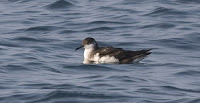
It was like an epiphany, spending five days learning how to use my binoculars and telescope. I'd never been in such a long relationship with them. I also learned how to manage my expectations. When you see a figure like 3024 Manx shearwaters in that period, it’s tempting to think they were streaming past. Divide that number by the 3600 minutes that twelve hours a day makes and the stream reduces to a trickle. Add the fact that shearwaters also tend to clump into groups of anything up to twenty and there's actually an awful lot of quietness out there.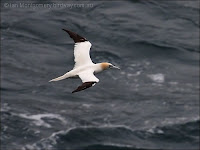
We did have the constant company of gannets. Who could complain about that? The local shags and fulmars also went about their business. And the paperwork kept us busy. Every hour we monitored the state of the wind, clouds, sea and its glare. To get an accurate reading for the wind meant a scramble up 50 metres to the top of the cliffs. Twelve times a day for five days... strewth, I climbed the equivalent of three Munros. No wonder my packed breakfast disappeared faster and faster each day.
The rhythm of scanning, recording and monitoring kept boredom at bay and gradually became the normal stuff of life. The rest of the world lost focus, turned unreal, irrelevant. Michael Jackson could have died and we wouldn’t have noticed (actually, he already had).
Back to 7:36 on the Sunday morning, I was yet to settle in to this pace. The first Balearic slipped past to set going another rhythm – ten that day; fifteen the next; and so on. We were counting beats, beats in the passage of sea life.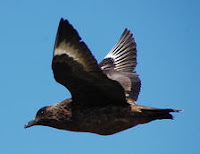
By eight o'clock the first of very few auks – a razorbill – had entered the records and my wind-climb produced a peregrine falcon. On the next hour I missed a passing great skua. Another pattern developed; it became a standing joke that the skuas would wait for me to start my ascent. My compensation that time was ravens and, at ten o'clock, a wheatear. The ensuing hour the Balearics peaked at four and I finally had a good enough view of one to honestly add it to my British list.
The morning ticked on. At twelve we broke for an hour, the period of maximum glare, then settled back to the rhythm. Before long, a sooty shearwater appeared, looking like a gigantic swift skimming the ocean. Another British first for me, we counted twelve in the entire five days.
A land-based distraction punctuated the afternoon: a pair of choughs probing the turf on the cliffs behind us. Meanwhile on the non-avian front Julie was having a quiet time until a basking shark appeared, quite close by. For me the day was indeed full of firsts.
And the weather held. We needed the umbrellas against twelve full hours of sunshine. It was a different story on the Monday. ⇐ ⇒
Tuesday, 1 September 2009
Extinction is for Ever
Fuck the anniversary of the start of World War Two. That of the death of the last passenger pigeon is far more symbolic of mankind's latent Nazism, but on an entire species level. Reduce a population of wild birds from billions to zero in little more than a century? Impossible, the sustainable-hunting fraternity will tell you. No, we are capable of anything, except adjusting our own behaviour to accommodate the rest of the planet.
Raven, Redditch

First of the month, so my rather irregular jaunt round the coppice at Walkwood to get the September list going. Well, last month I was on my voluntary job in Cornwall; in July on an outing with the RSPB at Cannock Chase; June dipping on purple heron at RSPB Saltholme... Dave and I hadn’t gone far into the wood when a loud cronk issued from the canopy.
So, out on the moors, up a bleak hill or on some storm-lashed cliffs, raven would have come to mind immediately. But in Redditch? I caught a black shape flap noisily away above us. It was indisputably a raven.
The call took me back a few days to walking back from Tesco, a route through suburban Redditch, when I also heard a single cronk. I looked up then, saw nothing and dismissed it as a figment but now realise that it too must have come from a raven. The species does seem to be spreading. I see it regularly at Bittell and reports appear on BirdForum from Upton Warren, so I can't be long adding it to that list.
There's no reason, apart from persecution, why these “honorary raptors” shouldn't spread. I used to see them regularly in the Bay Area where, like golden eagles and harriers, they thrive in the absence of gamekeepers. Funny that, ain’t it?
Monday, 31 August 2009
Shearwater Spectacle on YouTube
The shearwater picture on The New Dharma Bums is impressive enough but the YouTube video, although indistinct, gives a better impression of the sheer (deliberate pun!) numbers out in, presumably, Monterey Bay. Also presumably, they are sooty shearwaters. I occasionally saw this kind of carpet of birds when I lived in California but never over such a large area.
Sunday, 30 August 2009
Making a Website with ASP.NET and HTML
Microsoft provides Visual Web Developer Express as a free download to design websites built on their .NET technology. .NET is nothing more than a common set of functions for interacting with a user and ASP.NET implements it for the Web via Microsoft’s Active Server Pages (ASP). These create the HTML from which a browser, like Internet Explorer, builds a Web page.
OK, that's the jargon. The bottom line is: you can cut all that crap and just use Visual Web Developer (VWD) as an HTML editor. It does some of the tedious typing for you by filling in text it knows you'll need and even makes it XHTML-compliant. And if you want to try any of the fancy stuff in .NET, like master pages and reusable code, it’s there for you.
I've already hinted at using this to design a website and the resulting mish-mash appears at my birding/writing/programming pages. Yes, it looks like I’m not going down the Drupal route: I’m the sort of control freak that likes to programme as close to bare metal (or silicon) as possible.
And really, VWD is simple, for simple pages. It’s only when you start pushing the technology that the learning curve becomes as vertical as the brick wall against which you feel you're banging your head. You have to try the whistles and bells one at a time.
Most frustrating recently has been CSS (Cascading Style Sheets). This is supposed to be the XHTML way to go: it separates style from content, presentation from the actual words. However, something as simple as centring images seems to require such an inversion of the thought processes that Einstein would struggle with it. This is not VWD’s fault: it merely conforms to the coming standards.
It did have one big roadblock when testing the website locally, which might drive the less tenacious away. So, here it is, cleared: Internet Explorer cannot display the webpage.
PS. I would never advocate not using the <p> element to mark up an HTML paragraph. After all, a paragraph is a paragraph, right? But look in your newspaper. Is there a space between paragraphs? Check the latest, or any, Harry Potter. Spaces there? The Bible? Goddammit, even an HTML reference book? Spaces between paragraphs? No.
Then along comes HTML itself. “I know: let's stick a space in between paragraphs.” Fucking brilliant, mate. So, here's a nasty, but CSS-compliant, way to remove the space and indent the way it used to be:p {text-indent:1.2em; margin-top:-1em;}
p.scene {text-indent:0em; margin-top:0em;}
Now just add class=”scene” to the first paragraph of each piece. Scrivens!
Saturday, 29 August 2009
Nanotechnology: Don’t Worry, Be Nosy
Cornelia Dean in the New York Times asks her readers if they worry about nanotechnology. She needn't worry: people worry, full stop. It's a neat way of invalidating. It totally sets up the framework in which any future discussion will take place. That framework is one of fear. Wouldn't an unprejudiced enquiry be more productive?
I say this not necessarily as a supporter of nanotech but as one who has used it in a thread running through my science fiction novel. It’s interesting, goddammit, not another scare story. But that's precisely why I make it scary in the book. Scary sells.
Friday, 28 August 2009
Grey Phalarope, Witcombe, Gloucestershire

This year I’m doing well on phalaropes: red-necked added to my British bird list two months ago; and only my sixth sighting anywhere of grey today. What better compensation for dipping on the wryneck that's been showing at the reservoir the last couple of days? At first, distant, the phalarope flew after five minutes – right to our edge of the water – for binoculars-filling views. They're not shy.
It was moulting into winter plumage and impossible to sex. The female of the phalaropus genus, like the dotterel, is the colourful one and does all the courting. Oh, to be a phalarope. Hang on, though. The bloke gets left on the tundra with the kids while her-outdoors buggers off back to the African oceans. This wader, along with the red-necked, is also unique in spending its non-breeding life at sea. So, today’s bird was probably female.
In summer plumage the gal’s body and neck are red, as are the male’s but more blotchily so. In fact, they're called red phalaropes in the USA, where they're also considered the rarest of the genus. Rarest because America has a third phalarope, Wilson’s. It’s a landlubber but “she” still wears the trousers.
Thursday, 27 August 2009
Black Terns, Upton Warren

An influx of these through the Midlands in the bad weather yesterday left three over the Moors Pool this morning. Without expecting them, they're easy to overlook initially. The adults have largely moulted into winter garb, which along with the juveniles’ plumage, renders them white below and only somewhat greyer above than common terns.
Their behaviour gives them away. Their constant, bouncy flight brackets swift plunges to the water’s surface to pick off insects. Closer inspection, even just through binoculars, reveals the darker shade, a hint of collar and, on the youngsters, a definite leading dark band to the wings. For contrast a common tern did join them later and was clearly bigger and sturdier too.
Despite missing the late spring’s black terns in breeding plumage, it was good to add these to the year list and moreover to my score from September last year, which now stands at 645. I used that date as the start point for my round-the-world twelve-month list but may push it back to October because I’m off to Malta in a couple of weeks. More of that later, I’m sure.
I spent an hour in the lapwing (east) hide, absorbing these birds plus a very obliging common sandpiper and male kingfisher. I know this now because it wasn't wearing “lippy”, as someone put it (the female has a red base to its bill).






